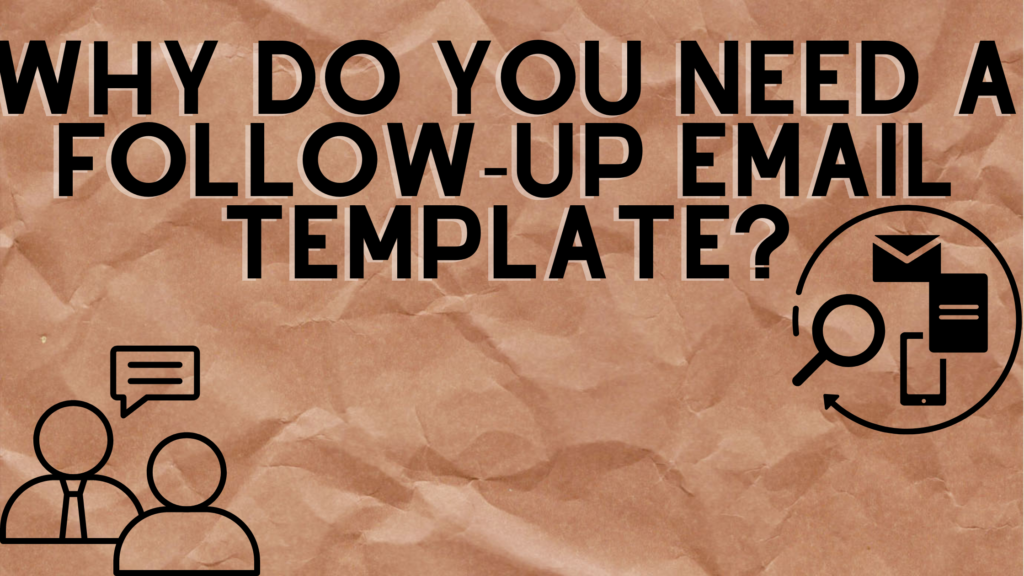
What is a follow-up email?
Simply put, a follow-up email is a series of emails sent after a critical point in the sales funnel to close the deal. A great follow-up email template is immensely helpful.
Follow-up emails are effective because:
- It helps you build trust step by step and increase the conversion rate
- Filter your audience (helps narrow down legitimate leads)
- Be the source for future recommendations.
- Add value to your prospects in every interaction
- Build credibility in your organization and familiarises company name.
- Differentiation from competitors
Nowadays, most marketers and sellers assume it’s safe to assume that prospects aren’t interested if they don’t get a response to their emails. Instead, they move on to new opportunities and completely abandon using follow-up emails to get prospects interested in your product/service.
On average, only 2% of sales come from the first touchpoint (about 8 touchpoints required before purchase). You miss 98% of successful deals because you don’t follow up. There are many reasons why prospects don’t reply to your emails. Maybe they were busy, their inbox was complete, they didn’t need your services at the time, or they just missed your email. As a seller/marketer, your job is to generate leads that meet your product/service needs. Don’t give up easily!
Why is a follow-up mail important?
An average business worker receives about 121 sales follow up emails a day, so emails are easily lost in the chaos. Most prospects prioritize emails from colleagues, business partners, and customers. Responding to and opening cold emails from businesses is secondary, emphasizing the importance of follow-up emails. Follow-ups act as a ‘gentle reminder’ in case a prospect misses an email or forgets to reply. It’s essential to remember that every follow-up email that is sent provides value to the opportunity.
When to send a follow-up email?
Before we get into how to write follow-up emails, how often should follow-up emails be sent? An important consideration is whether the email response is time sensitive. For example, you invite someone to an event. We may set a deadline for reply. In this case, you may want to send a polite follow-up email immediately, which is fine. You may submit a professional request expeditiously, knowing that it will not harm your reputation or relationship. Suppose you want to send a follow-up email to someone you’ve never met or have a professional relationship with. In this case, we recommend waiting about 5 days (1 week). Email is crucial when it comes to follow ups.
Elements to write a follow-up email template
1. Define your objective
Please do not send an email if your intentions are not clear. Decide ahead of time what you want to accomplish with each follow-up email. The main goal, of course, is to get in touch and convert prospects into paying customers. However, that may not be the case for your first follow-up email. So perhaps it needs to be lubricated a little. Send a follow-up email after no response from the receiver alone.
2. Have a clear subject line
Your goals could be booking a demo, getting a lead to sign up for a free trial, meeting schedule, or closing a sale. The email subject line is more important than the actual content of the email. After all, subject lines are one of the first things prospects see.
Subject lines determine the success or failure of cold email campaigns. Avoid using “trigger spam” words to trigger spam filters, which move the email to your spam or junk folder. 69% of email recipients mark emails as spam based solely on the subject line. This is very important for a sales follow-up too.
3. Introductory line
Remember that the average business, receives about 121 emails a day, so it’s possible that the recipient of your email won’t remember who you are? More likely. For this reason, it is important to include personal connections, unique identifiers, or common interests. This gives them context so they can remember you.
Perhaps it’s essential to help boost their memory with the opening lines by drawing attention to previously sent emails.
4. Add value to your mail.
Email recipients know the importance of valuable content. You don’t care if you receive an email that doesn’t add value to your life. This is probably why no reply is generated due to the email being worthless. Don’t send follow-up emails without adding more value than before. You have to prove your worth.
5. Have a catchy CTA
Your email should be easy to answer. It has to be practical. And how exactly do you do that? Add a compelling call to action (CTA). Don’t miss the CTA. Many follow-ups have killer subject lines and content but weak CTAs that don’t lead to the desired action.
6. Have an automated follow-up response
Sending follow-up emails manually can be difficult. Especially when you need to track them one by one and see which prospects are worth your attention. Instead, cold email automation tools that let you create automated follow-up cycles with different settings are helpful. Automating your follow-up ensures uniformity too. Email tracking software are immensely useful.
Best practices to follow while writing a follow up email template
There are many types of follow-up emails, so some of these tips may or may not apply to you. However, here are some general practices for email bodies that are considered best: Don’t forget to keep things short. Learn how to write one here.
1. Keep the email very brief
If you follow up after an interview, introduction, or meeting, personalize it by including something specific to the person mentioned. Ideally, you could say that it was essential to that person. This helps improve your memory while showing that you are listening carefully. A follow-up email can help hit your pitch target fast.
2. Show that you are genuine
Yes, follow-up emails are pretty predictable and formulaic. But that doesn’t mean you can’t be authentic in your communication. Don’t use generic empty messages. Really think about the specific elements you want to mention to boost your memory. And if possible, keep the tone of the conversation. It’s easy to read and write, and you don’t feel obligated to use a formal tone in your response. Wait for a response for a while.
3. It is better to include the original text that you are referring to
If you’re following up on a previous email, don’t let the recipient search for the original email or rewrite the email. Reply to everyone on the email, then remove yourself from the recipient list so that person has all the context they need. If the original email had attachments, attach them again. In the above case, please don’t make them read the original email again.
4. Make sure that your ask is clear
Summarize with clear questions such as: Do you think you can provide this data for the period from April 25th to May 31st?” Even if the original email contained multiple queries or data points, simple or small queries increase the chances of a response.
Refer to this link for a Follow Up Email Template

